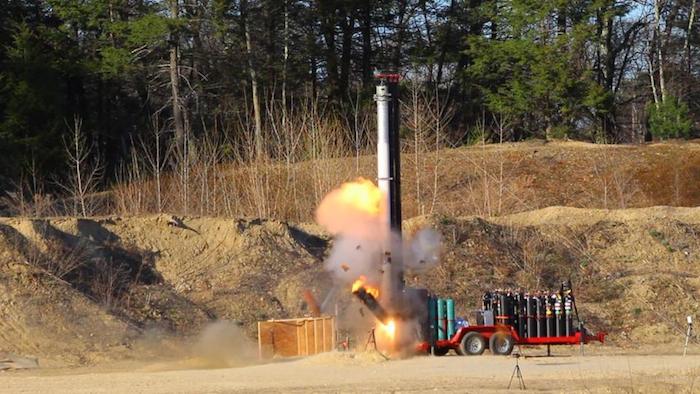.

The BU Rocket Propulsion Group built and designed the Mark V engine for their Starscraper rocket. At a test in a defunct Sudbury sand quarry in early May, software malfunctioned, causing an explosion.
It’s the sarcastic refrain when someone fails at a task that just doesn’t seem like it should be that hard: “It’s not rocket science.”
But what about when a hardworking team experiences a huge setback on something that is really hard — such as building a rocket that can reach the edge of space?
Failure, it turns out, is an essential part of rocket science.
For three years, ambitious Boston University engineering students have been working to be the first amateur group to launch a hybrid rocket into space. The undergraduate members of the BU Rocket Propulsion Group put in long hours to design, build, test, and raise funds for the project.
In early May, they attempted a static test of their newest, most powerful rocket engine. That meant they wanted the engine to burn, but no lift-off. The engine would be anchored to the ground.
Amateur groups have been pushing the boundaries of rocketry for years, but the BU team was focused on a hybrid rocket — fueled by both liquid and solid fuel. The technology offers a gentler ride than solid fuel rockets, which appealed to the team because it might allow them to launch a scientific instrument into space.
The engine alone takes two hours to fuel. Expectations and excitement were high — this was an important test before a planned cross-country tip this summer to hopefully use the engine to launch their Starscraper rocket to the edge of space.
Unfortunately, the test didn’t go as planned. A software crash led to a valve getting stuck open. There was an explosion. The fire was quickly extinguished by the fire department.
This is the kind of failure that would crush many people — countless hours of work and then the major test of the technology blows up in a way no one expected. Most people wouldn’t handle a situation like that with grace, but learning from such failures is one of the most important things to learn when engineering a new and complicated system.
“At first you get really emotionally wrapped up in each one, but every time you put it on the launch pad or the test bed, you just have to be willing to say goodbye to it,” said Armor Harris, the leader of the club, who graduates this month and will take a job working on rockets at SpaceX, which designs and manufactures rockets.
No one likes it when things go wrong, but for this team the test failure was valuable — it immediately gave them information about vulnerabilities and real-life scenarios difficult to model in the lab. They can use the information when they rebuild and try again next year.
Joseph Beaupre, who will take over the team next year, said that there wasn’t much moping.
“We got right down to analyzing the data,” Beaupre wrote in an e-mail. “Rockets are high risk, high reward. Not only that, but experimental rocket engines often fail during early testing. Everyone on the team understands its just part of the process.”
The team didn’t lose the whole rocket, and they are already planning to rebuild the combustion chamber and the nozzle, as well as fix the devices that control the valves.
“It has to be part of the attitude you have when you’re trying to figure out how it works and all the bugs. You don’t expect it to go perfectly,” Harris said.
An explosion is never part of the plan. But things rarely are, outside the classroom.
Quelle: The Boston Globe
4612 Views
